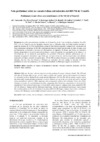Please use this identifier to cite or link to this item:
https://accedacris.ulpgc.es/jspui/handle/10553/625
| Title: | Nota preliminar sobre las características estructurales del Rift NE de Tenerife | Other Titles: | Preliminary results about structural features of the NE rift of Tenerife | Authors: | Carracedo, J.C. Perez-Torrado, Francisco-Jose Rodriguez-Badiola, Eduardo Balcells, R. Guillou, Hervé Trolll, V. R. Paris ,Raphael Michel Martín Escorza, Carlos Hansen Machín,Alex Roberto Rodriguez-Gonzalez, Alejandro |
UNESCO Clasification: | 250621 Vulcanología | Keywords: | Islas volcánicas oceánicas Rifts Geología Canarias Tenerife, et al |
Issue Date: | 2008 | Project: | CGL2005-00239 (Plan Nacional I+D+i) | Journal: | Geotemas (Madrid) | Conference: | VII Congreso Geológico de España | Abstract: | Los rifts son estructuras cruciales en el desarrollo de las islas volcánicas oceánicas. Los rifts
NW y NE de Tenerife son dos ejemplos extremos por su diferente edad, actividad eruptiva reciente y
grado de erosión. El rift NW ha permitido evaluar la distribución espacial y temporal del volcanismo en
estas estructuras volcánicas. El rift NE, prácticamente inactivo desde hace decenas de miles de años, está
profundamente erosionado y presenta en afloramiento el enjambre de diques que forma su estructura
interna, alcanzándose un acceso aun más profundo a través de galerías. La cartografía de los diques y la
determinación de su polaridad geomagnética ha permitido diferenciar distintas poblaciones que se
disponen en paquetes alternantes, sugiriendo que las fases intrusivas ocurren en periodos concentrados
separados por largos periodos de quiescencia. El rift NE ha tenido al menos tres grandes deslizamientos
laterales, dos de ellos (La Orotava y Güímar) ya conocidos. En este trabajo se describe de forma
preliminar el tercer deslizamiento y el volcán central anidado de Micheque surgido en su interior. Rifts are the most relevant structures in the geology of oceanic volcanic islands. The NW and NEt rifts of Tenerife differ in age, recent eruptive activity and erosion. Spatial and temporal distribution of volcanism has been defined in the young (mainly Holocene) NW rift. The NE rift, deeply eroded, shows the dense dyke swarm forming its internal structure. Deeper access to the core of the rift can be reached using groundwater galeries. Dyke mapping and geomagnetic polarity determination shows that dykes arrange in groups of a predominant polarity, suggesting that intrusions concentrate in short periods separated by long spans of quiescence. At least three lateral massive collapses have mass-wasted the NE rift, the Orotava, Güímar and the Micheque landslides, the last, not mentioned previously, mass-wasted the northwest flank of the rift. Continued volcanism filled the Micheque collapse depression, evolving to construct the Micheque central (differentiated) volcano, nested in the collapse embayment. |
URI: | https://accedacris.ulpgc.es/handle/10553/625 | ISSN: | 1567-5172 | Source: | Geotemas [ISSN 1567-5172], v. 10, p. 1265-1268. (VII Congreso Geológico de España, Las Palmas de Gran Canaria, 14-18 de julio, 2008) |
| Appears in Collections: | Actas de congresos |
Page view(s)
489
checked on Feb 10, 2024
Download(s)
228
checked on Feb 10, 2024
Google ScholarTM
Check
Share
Export metadata
Items in accedaCRIS are protected by copyright, with all rights reserved, unless otherwise indicated.
